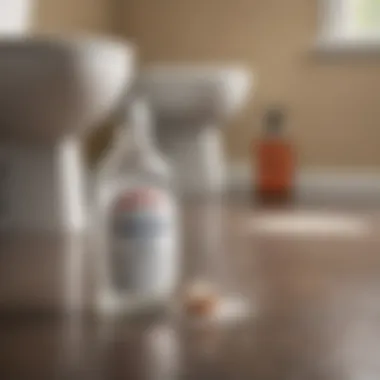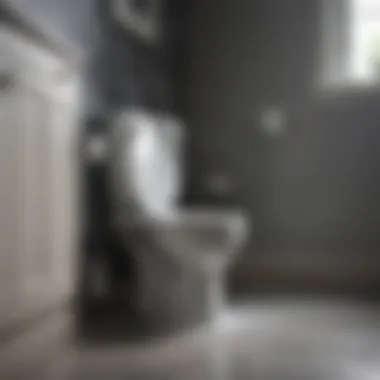Effective Methods to Clear a Clogged Toilet


Intro
A clogged toilet is a common household dilemma that often creates frustration and inconvenience. Homeowners frequently confront this issue, yet many are unprepared to tackle it effectively. Understanding the causes of clogs and knowing practical solutions can ease the burden associated with this problem.
Clogs can arise from numerous factors, including excessive toilet paper use, foreign objects, or the buildup of waste and minerals over time. Each situation may require a different approach, ranging from immediate fixes to preventive measures.
This guide aims to provide readers with a comprehensive look at the efficient methods and techniques for addressing a clogged toilet. We will explore mechanical tools like plungers and augers, as well as innovative home remedies using everyday items. By familiarizing yourself with these approaches, you can act swiftly when faced with a clog, thus minimizing disruption to your daily routine.
Understanding the various solutions available will not only help in immediate crises but also equip you with the knowledge to maintain your toilet's functionality over the long term. Here, we will present detailed evaluations of each method, highlighting their effectiveness and ease of use, ensuring all homeowners have the information needed to demystify toilet problems.
Understanding Toilet Clogs
Understanding toilet clogs is essential for every homeowner. Toilets are a vital part of our daily lives. When they don't function properly, it can create frustration and inconvenience. Recognizing what causes clogs and how to identify them helps in preventing minor issues from becoming major problems.
Several factors contribute to toilet clogs. These can often arise from straightforward mistakes or daily habits that may go unnoticed. Being informed about these causes enables you to take proactive steps in toilet maintenance.
Furthermore, knowing how to spot the signs of a clogged toilet can save time and resources. An early response leads to quicker fixes and often avoids costly plumbing bills. Therefore, a comprehensive understanding of clogs is more than just a practical necessity—it is a form of empowerment.
Common Causes of Clogs
Toilet clogs usually stem from blocking items or excessive usage of inappropriate materials. The most frequent causes include:
- Excess Toilet Paper: Using too much paper can create a dense mass that the water has difficulty flushing away.
- Foreign Objects: Items like sanitary products, wipes, or toys can unintentionally end up in the toilet and block the drain.
- Flushing Incorrect Items: Many people do not realize that some things should never be flushed, such as cotton balls or dental floss.
The build-up of minerals and hard water deposits can also contribute to pipe narrowing, making it easier for clogs to form.
Signs of a Clogged Toilet
Being able to identify the signs of a clogged toilet is crucial. Early detection can prevent more severe issues. Common signs include:
- Slow Drainage: If the toilet takes longer than usual to empty, a clog may be building up.
- Gurgling Noises: Sounds coming from the drain when you flush or use the sink can indicate air trapped in the piping system.
- Overflowing: Water may rise quickly when you flush, signaling a serious blockage.
Recognizing these signs will enable you to take swift action, minimizing disruption to your routine and protecting your plumbing system.
Essential Tools for Toilet Maintenance
To effectively address a clogged toilet, having the right tools at your disposal is vital. Proper tools can enhance your ability to handle clogs with more skill and efficiency. Selecting effective tools can make the difference between a simple fix and a day-long ordeal. Not only do handy tools speed up the process, but they also minimize the risk of damaging your plumbing. Furthermore, understanding how and when to use these tools is equally important, as improper usage can worsen the situation.
The Plunger: A Fundamental Tool
One cannot understate the significance of a plunger in the realm of toilet maintenance. Typically made from rubber and wood, the plunger works by creating a vacuum that dislodges clogs. It is essential to invest in a high-quality plunger, as inferior models may not provide the necessary suction needed to clear the blockage. For toilets, a flange plunger is especially efficient, as its design accommodates the unique shape of a toilet bowl. Using a plunger correctly involves ensuring that water covers the rubber part, providing effective suction.
To use a plunger effectively:
- Ensure there's sufficient water in the bowl to cover the plunger.
- Position the plunger over the drain hole.
- Push down slowly before pulling up quickly to create suction.
- Repeat this action until the clog dislodges.


Maintaining a plunger in good condition is equally crucial. Regularly cleaning it can prevent odors and bacterial growth.
Toilet Augers: When to Use Them
Toilet augers provide an advanced solution for tougher clogs that a plunger might not dislodge. This tool consists of a long, flexible cable with a curved end designed to reach and remove clogs deep within the toilet's piping. An auger is particularly useful for blockages caused by foreign objects or stubborn waste.
To operate a toilet auger, follow these steps:
- Insert the auger into the toilet bowl until it meets resistance.
- Slowly twist the handle to extend the cable further into the drain.
- Once you feel the obstruction, continue twisting to break it up.
- Gently pull the auger back, hopefully removing the clog.
A critical aspect to consider with an auger is the potential for scratches on the porcelain. Care should be taken to maneuver the tool carefully during its use. A toilet auger offers a much broader range in resolving clogs that require more elbow grease.
Wet/Dry Vacuum: An Alternative Solution
For those who may not have traditional plumbing tools available, a wet/dry vacuum serves as an alternative means to address a clogged toilet. This tool is particularly helpful for removing water and debris from the bowl. Some homeowners report success in using a wet/dry vacuum to suction out clogs. To employ this method, follow these basic steps:
- Set the vacuum to the liquid setting.
- Insert the hose into the toilet bowl, ensuring a tight seal.
- Activate the vacuum to suck out water and waste.
While this method may not be suitable for every situation, it can be a worthwhile addition to your toolkit. It's important to monitor the vacuum's effectiveness and recognize when more traditional methods, such as plungers or augers, should be attempted.
Remember, the right tool can save time and effort in toilet maintenance. [source: (en.wikipedia.org), (britannica.com)]
Home Remedies for Clogs
Addressing clogs can be frustrating and often leads one to seek immediate solutions. Home remedies for clogs offer a practical approach before escalating to professional help. These methods typically utilize common household items, making them accessible and cost-effective. The primary advantage is convenience; many remedies only require simple ingredients already found in most homes.
In addition, using home remedies can reduce reliance on chemical solutions that may harm plumbing or the environment. However, it is crucial to consider the nature of the clog. Some severe blockages may not respond to these methods. Understanding the limits of home remedies can save time and effort.
Baking Soda and Vinegar: A Chemical Reaction
Baking soda and vinegar create a powerful chemical reaction that can effectively dislodge minor clogs. This remedy is particularly useful for organic material that may cause blockage.
- First, pour a cup of baking soda directly into the toilet bowl.
- Follow this with a cup of vinegar.
- Allow the mixture to sit for approximately 30 minutes, during which time it will fizz and bubble, working to break down the clog.
- Afterward, flush the toilet to help clear away any debris.
This method is relatively safe for your plumbing and can also help neutralize odors.
Dish Soap: A Simple Lubricant
Dish soap serves as a lubricant that can assist in easing clogs. It can help to break down greasy substances or any other sticky materials causing blockage.
- Begin by pouring about half a cup of dish soap into the toilet bowl.
- Allow it to sit for 10-15 minutes to work its way through the pipes.
- Then, flush with hot water to assist with dislodging the material.
Using dish soap is an excellent way to simplify the clearing process, particularly if dealing with greasy substances from food or other sources.
Hot Water: Leveraging Temperature


Hot water can work wonders for clearing clogs, especially those caused by soft materials.
- Boil about two gallons of water.
- Once the water is boiling, allow it to cool slightly. Pouring boiling water directly into the toilet can crack it.
- Slowly pour the hot water into the toilet bowl from waist height to create pressure against the clog.
- Follow up with a flush to see if the blockage has cleared.
Hot water can help break down solidified materials and assist in their removal. It is simple yet remarkably effective.
Professional Help: When to Call a Plumber
Addressing a clogged toilet can often be a do-it-yourself task, but there are situations when professional assistance is necessary. Knowing when to seek help can save you time, money, and further complications. Plumbers bring expertise, tools, and experience that are crucial for more severe issues.
For many homeowners, the decision to call a plumber depends on factors like the severity of the clog, recurring issues, and personal comfort with toilet maintenance. Professional plumbers can diagnose underlying problems, such as structural issues or broken pipes, that may not be apparent to the average person. When clogs happen frequently or persist despite your attempts, it is an indication of a more pressing problem.
Signs Indicating a Need for Professional Assistance
Recognizing the signs that suggest a plumbing emergency is vital in maintaining your home's hygiene and functionality. Certain symptoms signal that the situation exceeds typical household maintenance:
- Frequent Clogs: If your toilet clogs regularly, it suggests a deeper systemic issue that traditional methods may not resolve.
- Multiple Fixtures Affected: Occurrences where other drains, such as sinks or bathtubs, back up when flushing the toilet often indicate a blockage in the main sewage line.
- Unpleasant Odors: Persistent unpleasant smells in the bathroom can indicate sewage issues or trapped waste within your plumbing system.
- Gurgling Sounds: If your toilet makes gurgling noises upon flushing or when other fixtures drain, this could signal air trapped in the plumbing or an impending clog.
- Water Pooling: Water that does not drain properly or pools at the base of the toilet can indicate a problem with the wax seal or a significant clog that requires a plumber's assessment.
Choosing a Reliable Plumbing Service
Finding a good plumber can be as important as recognizing when to call for help. Here are some tips for selecting a reliable plumbing service:
- Check Reviews and References: Research local plumbing services online, focusing on customer reviews and ratings. Websites like Reddit and Facebook can provide insights into past customer experiences.
- Verify Credentials: Ensure the plumber is licensed and insured in your state. This protects you from liability should something go wrong during repairs.
- Request Estimates: Obtaining multiple quotes can help you gauge average pricing and avoid overpaying. Make sure the estimate includes the breakdown of costs for labor and parts.
- Inquire About Experience: A plumber with extensive experience is often better equipped to handle unexpected complications that may arise.
- Look for Warranties: A reliable plumbing service should offer warranties on their work. This shows their confidence in services rendered and offers you peace of mind.
Ultimately, knowing when to seek professional plumbing help and how to choose a trustworthy service can prevent further complications and expenses.
Understanding these factors can empower homeowners to maintain their toilets effectively while ensuring that more significant issues are addressed by skilled professionals.
Preventative Measures for Future Clogs
Preventative measures for future clogs are an essential topic within toilet maintenance. Understanding how to effectively minimize the chances of encountering clogs, not only saves time and stress but also reduces the cost of potential plumbing services. By implementing a few practical strategies, homeowners can create a more efficient and hassle-free toilet experience.
Regular Maintenance Practices
Regular maintenance practices play a crucial role in keeping toilets functioning properly. Establishing a routine schedule can help identify small issues before they become significant problems. Regularly checking for leaks, ensuring that the flushing mechanism works correctly, and cleaning the toilet bowl can prevent build-up of substances that lead to clogs. A once-a-month deep clean, using an appropriate toilet cleaner and brush, can keep the inner workings of the toilet in a healthy state.
Understanding What Not to Flush
Awareness of what not to flush is vital in preventing toilet clogs. Generally, toilet systems are designed to handle human waste and toilet paper only. Common culprits behind clogs include:
- Feminine hygiene products
- Paper towels
- Wipes labeled "flushable"
- Food scraps
- Dental floss
Educating everyone in the household about these prohibitions can make a considerable difference. Adopting this understanding minimizes the risk of unexpected clogs while promoting good habits.
Using Toilet Tissue Wisely


Using toilet tissue wisely contributes to the longevity of a toilet’s functionality. It is important to choose the right type and amount of tissue. Thicker toilet papers, while providing comfort, can contribute to clogging issues. Opting for softer, thinner options can ease this concern. Additionally, using a moderate amount of tissue per use limits the risk of blockage arising due to excessive paper.
Environmental Considerations
In the context of toilet maintenance, environmental considerations have gained relevance as awareness of ecological sustainability rises. This section will explore the impact of various cleaning methods and the importance of choosing appropriate products that minimize environmental harm. By understanding these elements, homeowners can enhance their plumbing practices while contributing to a healthier planet.
When addressing a clogged toilet, the choice of products one uses plays an essential role. Many conventional cleaners contain harmful chemicals that can enter the water supply, causing contamination. In contrast, eco-friendly alternatives offer a safer route that achieves similar outcomes without detrimental effects.
For instance, opting for biodegradable or natural products can effectively manage clogs while reducing the overall carbon footprint.
"Choosing eco-friendly products is not just about plumbing; it’s about prioritizing the health of our waterways and ecosystems."
Additionally, some cleaning agents contribute to excessive water usage and strain local resources. Thus, it is crucial to align toilet maintenance practices with sustainable principles to ensure responsible water consumption. By integrating environmentally conscious methods into routine toilet upkeep, individuals hold the power to foster significant change within their households.
Eco-Friendly Products for Clog Management
Utilizing eco-friendly products for clog management is a proactive choice that benefits both the plumbing system and the environment. Various biodegradable and natural products can assist in clearing obstructions effectively. Here are a few recommendations:
- Baking Soda and Vinegar: A household staple, this combination creates a natural reaction that can help dislodge minor clogs. Simply mix baking soda and vinegar, allow it to fizz, and subsequently flush with hot water.
- Plant-Based Cleaners: Brands like Seventh Generation offer cleaning agents formulated from plant-derived ingredients. They effectively break down waste without introducing harmful chemicals into the system.
- Enzyme-Based Solutions: Products containing enzymes promote the breakdown of organic matter. They ensure toilets remain healthy without the need for harsh chemicals.
By integrating these products into regular maintenance routines, homeowners can preserve the environment while maintaining a functional toilet.
Water Usage and Toilet Flushing
Water usage is a critical factor in toilet maintenance and plumbing overall. Toilets account for a significant percentage of household water consumption. Thus, their efficiency directly impacts water conservation efforts. Traditional toilets can use anywhere from 3.5 to 7 gallons per flush, leading to considerable waste.
Modern advancements in technology have introduced low-flow toilets. These fixtures use only 1.6 gallons or less per flush, which dramatically reduces water usage per household. It is prudent to consider upgrading to these fixtures if the current ones are outdated.
Moreover, adjusting habits can greatly impact water conservation. For example, being mindful of double flushing or utilizing the toilet for non-waste purposes can prevent unnecessary water expenditure.
Incorporating practices that emphasize water efficiency not only eases the functionality of toilets but also aligns with broader environmental goals. As society progresses toward sustainability, recognizing the impact of water usage on the environment remains paramount.
End: Mastering Toilet Maintenance
Toilet maintenance is not merely a chore; it is an essential aspect of home care that ensures functionality and hygiene. Understanding how to address a clogged toilet is key to avoiding stress and potential damage to plumbing systems. In this article, practical solutions and approaches have been emphasized, reflecting the importance of having a well-maintained toilet in the home.
Summary of Effective Solutions
A multitude of solutions has been provided throughout the article, presenting various methods to alleviate toilet clogs. Each method has its unique advantages and challenges:
- Mechanical Tools: Plungers and toilet augers are effective for immediate physical unclogging. They utilize simple mechanics and can easily be found in most homes.
- Home Remedies: Baking soda, vinegar, and dish soap present eco-friendly options that can be as effective as commercial products. These remedies are economical and require simple ingredients.
- Professional Help: Recognizing when to contact a plumber is crucial, especially in severe cases that involve deeper plumbing issues.
- Preventative Strategies: Keeping regular maintenance routines and understanding proper flushing practices can help mitigate future problems.
By integrating these solutions into regular home maintenance, homeowners can effectively master toilet maintenance, ensuring their systems remain functional over time.
Encouraging Proactive Behavior
Proactive behavior in toilet maintenance is essential. It is often easier and less costly to prevent clogs than to deal with them after they occur. Here are some critical practices to adopt:
- Regular Inspections: Conduct periodic checks on toilet performance. Look for slow drains or persistent odors that may indicate issues.
- Dispose Wisely: Educate all household members about what can and cannot be flushed. Items like wipes or excessive tissue can lead to clogs.
- Maintenance Kits: Keeping a basic toolkit for toilet maintenance easily accessible will allow for prompt action when issues arise.
- Awareness: Stay informed about the plumbing system. Understanding its idiosyncrasies can alert homeowners to potential problems before they escalate.
“An ounce of prevention is worth a pound of cure.”
This adage rings especially true in the context of toilet maintenance. By prioritizing preventative measures, homeowners can save time, reduce frustration, and avoid costly repairs.







